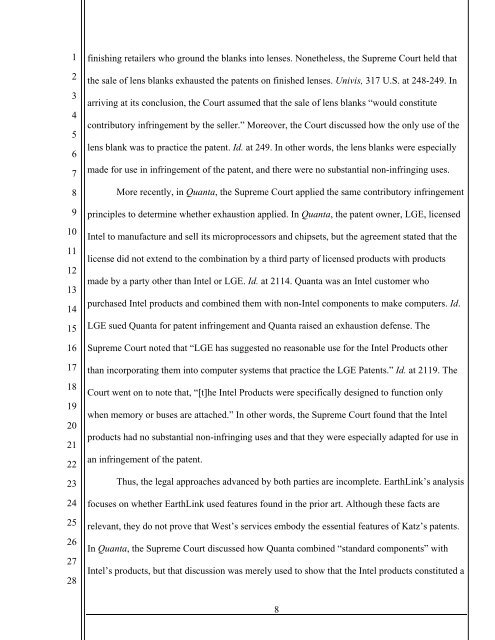Ronald A. Katz Technology Licensing v. Earthlink - IP Spotlight
Ronald A. Katz Technology Licensing v. Earthlink - IP Spotlight
Ronald A. Katz Technology Licensing v. Earthlink - IP Spotlight
Create successful ePaper yourself
Turn your PDF publications into a flip-book with our unique Google optimized e-Paper software.
1<br />
2<br />
3<br />
4<br />
5<br />
6<br />
7<br />
8<br />
9<br />
10<br />
11<br />
12<br />
13<br />
14<br />
15<br />
16<br />
17<br />
18<br />
19<br />
20<br />
21<br />
22<br />
23<br />
24<br />
25<br />
26<br />
27<br />
28<br />
finishing retailers who ground the blanks into lenses. Nonetheless, the Supreme Court held that<br />
the sale of lens blanks exhausted the patents on finished lenses. Univis, 317 U.S. at 248-249. In<br />
arriving at its conclusion, the Court assumed that the sale of lens blanks “would constitute<br />
contributory infringement by the seller.” Moreover, the Court discussed how the only use of the<br />
lens blank was to practice the patent. Id. at 249. In other words, the lens blanks were especially<br />
made for use in infringement of the patent, and there were no substantial non-infringing uses.<br />
More recently, in Quanta, the Supreme Court applied the same contributory infringement<br />
principles to determine whether exhaustion applied. In Quanta, the patent owner, LGE, licensed<br />
Intel to manufacture and sell its microprocessors and chipsets, but the agreement stated that the<br />
license did not extend to the combination by a third party of licensed products with products<br />
made by a party other than Intel or LGE. Id. at 2114. Quanta was an Intel customer who<br />
purchased Intel products and combined them with non-Intel components to make computers. Id.<br />
LGE sued Quanta for patent infringement and Quanta raised an exhaustion defense. The<br />
Supreme Court noted that “LGE has suggested no reasonable use for the Intel Products other<br />
than incorporating them into computer systems that practice the LGE Patents.” Id. at 2119. The<br />
Court went on to note that, “[t]he Intel Products were specifically designed to function only<br />
when memory or buses are attached.” In other words, the Supreme Court found that the Intel<br />
products had no substantial non-infringing uses and that they were especially adapted for use in<br />
an infringement of the patent.<br />
Thus, the legal approaches advanced by both parties are incomplete. EarthLink’s analysis<br />
focuses on whether EarthLink used features found in the prior art. Although these facts are<br />
relevant, they do not prove that West’s services embody the essential features of <strong>Katz</strong>’s patents.<br />
In Quanta, the Supreme Court discussed how Quanta combined “standard components” with<br />
Intel’s products, but that discussion was merely used to show that the Intel products constituted a<br />
8


